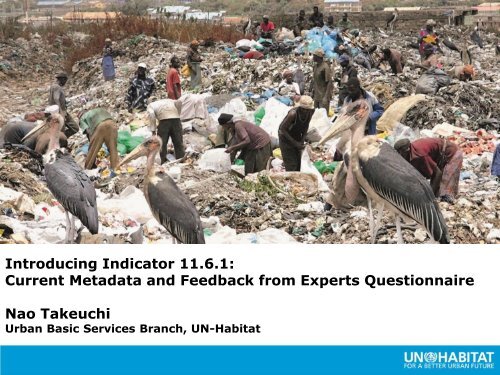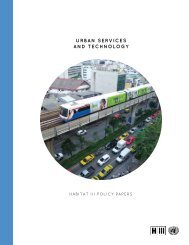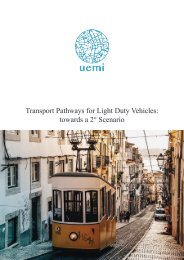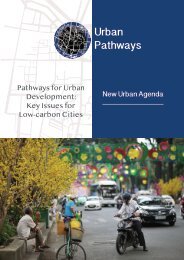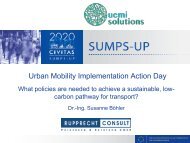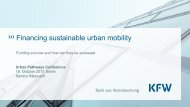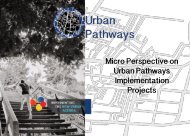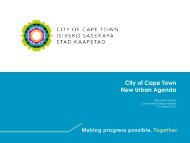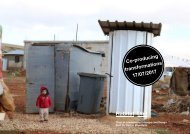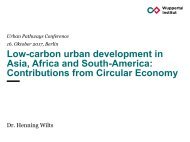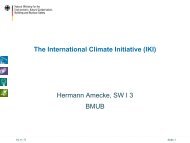Nao_Takeuchi_Waste
You also want an ePaper? Increase the reach of your titles
YUMPU automatically turns print PDFs into web optimized ePapers that Google loves.
Introducing Indicator 11.6.1:<br />
Current Metadata and Feedback from Experts Questionnaire<br />
<strong>Nao</strong> <strong>Takeuchi</strong><br />
Urban Basic Services Branch, UN-Habitat
Contents<br />
1. <strong>Waste</strong> Related SDG Indicators<br />
2. Scope of Monitoring and Terminologies<br />
3. Monitoring Methodology<br />
4. Capacity Development for Baseline Survey and<br />
Monitoring<br />
5. Inter-Agency Partnership for <strong>Waste</strong> Management<br />
Related SDG Indicators<br />
2
UN-Habitat<br />
& WHO<br />
UN-Habitat<br />
UNEP<br />
<strong>Waste</strong> SDG Indicators<br />
Sustainable Cities and SWM<br />
Goal 11: Make cities and human settlements inclusive, safe, resilient and sustainable<br />
Targets<br />
11.6 By 2030, reduce the adverse per capita environmental impact<br />
of cities, including by paying special attention to air quality and<br />
municipal and other waste management.<br />
Indicator<br />
% of urban solid waste regularly collected and<br />
with adequate final discharge with regards to<br />
the total waste generated by the city<br />
Goal 6: Ensure availability and sustainable management of water and sanitation for all<br />
Targets<br />
6.3 By 2030, improve water quality by reducing pollution,<br />
eliminating dumping and minimizing release of hazardous<br />
chemicals and materials, halving the proportion of untreated<br />
wastewater and substantially increasing recycling and safe<br />
reuse globally environment.<br />
Indicator<br />
Percentage of wastewater safely treated<br />
(Definition of ‘wastewater’ include septage<br />
and feacal sludge)<br />
Goal 12: Ensure sustainable consumption and production patterns<br />
Targets<br />
12.4 By 2020, achieve the environmentally sound management of<br />
chemicals and all wastes throughout their life cycle, in<br />
accordance with agreed international frameworks, and<br />
significantly reduce their release to air, water and soil in order<br />
to minimize their adverse impacts on human health and the<br />
environment.<br />
12.5 By 2030, substantially reduce waste generation through<br />
prevention, reduction, recycling and reuse.<br />
Indicator<br />
Treatment of waste, generation of hazardous<br />
waste, hazardous waste management, by type<br />
of treatment<br />
National recycling rate, tons of material<br />
recycled<br />
3
Issue 1<br />
Scope of Monitoring & Terminologies<br />
• Whether to include or exclude faecal sludge and sewage<br />
sludge in the monitoring scope?<br />
• Should the terminology be consistent with ‘municipal solid<br />
waste’ or ‘urban solid waste’?<br />
• Should this indicator monitor only ‘municipal solid waste’ or<br />
‘urban solid waste’ including other waste?<br />
• What other waste should be monitored through this<br />
indicator?<br />
4
Experts’ Feedback<br />
Whether to include or exclude FS and SS<br />
Should be excluded<br />
Should be included<br />
Answer 8 3<br />
Reason • Adding these two streams to municipal waste into<br />
indicator 11.6.1 is an unnecessary repetition of the<br />
information from 6.3.1 and 12.4.2, while obscuring<br />
information on the municipal waste stream.<br />
• Sewage sludge and faecal sludge use/require<br />
different infrastructure to collect from “normal”<br />
municipal solid waste, and they pose higher and<br />
different health risks than “normal” municipal<br />
waste.<br />
• There is no clear definition of urban solid waste that<br />
has been agreed internationally.<br />
• Although faecal sludge and hazardous wastes may be<br />
included in urban waste, these items may be difficult to<br />
disaggregate from current statistics on urban waste.<br />
• In general local government departments responsible<br />
(and therefore reporting) figures for municipal solid<br />
waste. Hazardous and faecal sludge are different.<br />
• It is very important to measure by parts because it<br />
would disturb the total results and show you a wrong<br />
picture of amount of waste.<br />
• In some countries they are disposed in mixed<br />
manner and inseparable<br />
• Target 11.6 is very broad in the sense that it<br />
actually seeks to reduce the “per capita<br />
environmental impact of cities”. In the spirit of<br />
target 11.6, we should apply a broader concept<br />
of “urban solid waste”<br />
5
Experts’ Feedback<br />
Terminologies in the target and indicator<br />
Should be ‘municipal solid<br />
waste’ and exclude ‘other<br />
waste’<br />
Should be ‘urban solid<br />
waste’ and exclude<br />
‘other waste’<br />
Should be ‘urban solid<br />
waste’ and include<br />
‘other waste’<br />
Answer 5 1 1 3<br />
‘Urban solid waste’ can<br />
include both ‘municipal<br />
solid waste’ and ‘other<br />
waste’<br />
Reasons • The term “municipal waste”<br />
is consistent with the exact<br />
terminology in the pertinent<br />
target (11.6), thus no need<br />
for additional explanations<br />
in the monitoring and<br />
reporting stage.<br />
• The term “municipal<br />
waste” has a wellestablished<br />
definition in<br />
solid waste management<br />
both literature and<br />
practice.<br />
• It would be always better to<br />
use the same terminology<br />
between the target and<br />
the indicator in order to<br />
avoid the confusion.<br />
• UNSD/UNEP questionnaire<br />
is available on municipal<br />
waste but not urban waste.<br />
• The nomenclature should<br />
be the one used by UNSD.<br />
• Keep definitions as<br />
simple as possible.<br />
Otherwise reporting will<br />
be a complete mess,<br />
with incomparable<br />
results, and therefore<br />
undermine the initiative.<br />
• An alternative might be<br />
"Proportion of municipal<br />
and other solid waste<br />
regularly collected and<br />
with adequate final<br />
discharge out of total<br />
municipal and other<br />
solid waste generated in<br />
cities“<br />
• Municipal waste refers to<br />
household waste, but in<br />
the cities are generated<br />
other types of waste,<br />
which in the case of Costa<br />
Rica are not municipal<br />
responsibility, but are<br />
handled under the EPR<br />
principle.<br />
• Commercial, Industrial<br />
and Hazardous Health<br />
Care solid waste are<br />
substantial waste<br />
streams in urban<br />
settings throughout the<br />
world cities and therefore<br />
needs to be addressed.<br />
• Sub-indicators for the<br />
type of waste with<br />
composite indicator that<br />
captures municipal and<br />
other wastes could work<br />
6
Experts’ Feedback<br />
What other waste should be monitored?<br />
Suggestions from Dr. Ljiljana Rodic-Wiersma<br />
• The indicator should monitor ONLY ‘municipal solid waste’<br />
• ‘Other waste’ should NOT be monitored but could be defined as<br />
<strong>Waste</strong> that either<br />
requires special treatment such as hazardous waste from<br />
• Industrial activities<br />
• Agricultural activities<br />
• Mining<br />
• Health care facilities (hospitals and other)<br />
enables special treatment such as<br />
• Agricultural organic waste<br />
• Construction and demolition waste from construction industry<br />
• End of life vehicles (motor vehicles that have reached the<br />
end of their useful lives) and<br />
• WEEE (<strong>Waste</strong> Electrical and Electronic Equipment)<br />
• However, WEEE should be included in the scope of this indicator monitoring<br />
because otherwise it cannot be captured in the other waste categories<br />
7
Experts’ Feedback<br />
Other suggestions<br />
Definition of ‘adequate final discharge’<br />
• By the current definition, 90% of all treatment & disposal will not be considered as ‘adequate<br />
final discharge’ therefore we will get the same value in the most of the cities in developing world.<br />
• The definition provided does not allow for gradual improvement – it is an exclusive binary<br />
system: all or nothing. Developed countries also started from open dumps of hazardous waste<br />
that caused serious pollution of local water resources and health effects on local residents. Their<br />
progress was gradual and spread over several decades, to arrive at the current state-of-the-art<br />
facilities with the necessary engineered controls for environmental protection.<br />
• For example, if a city brings their open dump to a controlled facility (three Cs – Confine,<br />
Compact, Cover), it is big step toward environmental protection, and should be<br />
acknowledged as such by the SDG indicator 11.6.1. How the indicator is defined now, there<br />
would be no difference between such a city and a city that just dumps their waste wherever the<br />
trucks unload. But their situations are not the same in terms of environmental protection.<br />
• The term should be replaced, as it has a strong connotation of disposal and not valorization<br />
8
Experts’ Feedback<br />
Other suggestions<br />
Definition of ‘adequate final discharge’ (cont.)<br />
• The types of treatment/disposal defined by Habitat as “adequate” may differ from the definitions of<br />
the UNSD/UNEP. It would be helpful to have further definitions of the terms “sanitary” and<br />
“environmentally adequate” mentioned above. The UNSD/UNEP questionnaire does not attempt<br />
to assess which facilities are following the management practices of pollution control or labour<br />
safety standards. It may be difficult to assess these types of management practices by<br />
facility.<br />
• The strict standard of ‘adequate final discharge’ can impose extraordinary burden on local<br />
government which does not have technical and financial capacity as well as local businesses that<br />
cannot afford environmental protection facilities and make them bankrupt. More gradual<br />
approach that can visualise local effort is needed.<br />
• Official reporting often do not capture the real situation. Verification by third parties would be<br />
necessary for monitoring.<br />
• “Discharge” is a term from the field of sewage and wastewater treatment. In SWM, the<br />
conventional term for this is: “treatment and disposal”, so: “Adequate Final Treatment and<br />
Disposal”.<br />
9
Expert Questionnaire Results<br />
Other Suggestions<br />
Definition of ‘Landfilling’<br />
• This states that landfilling is only of waste that cannot be reduced, recycled, composted or<br />
incinerated. This part of the definition is confusing as it appears to consider intent rather<br />
than the waste placed in the landfill or to define landfill as the negative of other processes.<br />
• In the definition fro "Landfilling" the requirement for “leachate Facility” is subjective and can result<br />
in countries investing their limited finances in inappropriate technologies. If it is stated that<br />
“landfill must have leachate facility” and this is not defined to include the spectrum of options from<br />
evaporation pond to RO then it can force investment to the wrong priority.<br />
Definition of ‘Total Solid <strong>Waste</strong> Generation’<br />
• This should not exclude waste quantities taken and recycled before waste collection, but rather<br />
include an estimation for this fraction<br />
10
11.6.1<br />
scope<br />
12.5<br />
scope<br />
Experts’ Feedback<br />
Sub-Indicators (WASTEAWARE Indicators)<br />
WASTEAWARE Indicators (Wilson et al, 2015)<br />
Using wasteaware indicators as sub-indicators would help visualise gradual improvement of SWM<br />
1<br />
2<br />
3<br />
Physical<br />
component<br />
Public health<br />
- waste<br />
collection<br />
Environment<br />
al control -<br />
disposal<br />
Resource<br />
value - ‘3Rs’<br />
- Reduce,<br />
reuse,<br />
recycle<br />
Indicator name and<br />
definition<br />
<strong>Waste</strong> Collection<br />
Coverage:<br />
% households who have<br />
access to a reliable waste<br />
collection service<br />
Controlled treatment or<br />
disposal:<br />
% of the total municipal solid<br />
waste destined for treatment<br />
or disposal which goes to<br />
either a state-of-the-art,<br />
engineered or ‘controlled’<br />
treatment / disposal site<br />
Recycling rate: % of total<br />
municipal solid waste<br />
generated that is recycled.<br />
Includes materials recycling<br />
and organics valorisation<br />
(composting, animal feed,<br />
anaerobic digestion).<br />
Extract from guidance notes in User Manual<br />
<strong>Waste</strong> collection coverage represents the access that the population of a<br />
city have to a waste collection service, including both formal municipal<br />
and informal sector services. A ‘collection service’ may be ‘door to door’ or by<br />
deposit into a community container. ‘Collection’ includes collection for<br />
recycling as well as for treatment and disposal (so includes e.g. collection of<br />
recyclables by itinerant waste buyers). ‘Reliable’ means regular - frequency<br />
will depend on local conditions and on any pre-separation of the waste.<br />
The ‘numerator’ in this calculation is the total waste that is dealt with<br />
in a ‘controlled’ facility (e.g for land disposal, composting or waste to<br />
energy). The ‘denominator’ is the total solid waste destined for<br />
treatment or disposal - that is the total waste generated less waste<br />
recycled or reused.<br />
<strong>Waste</strong> being accepted at a facility ‘counts’ towards this quantitative indicator if<br />
the facility has reached at least an intermediate level of control. To use land<br />
disposal as an example, and referring to the stepwise improvement of sites,<br />
both uncontrolled and semi-controlled sites would fall below the threshold,<br />
while controlled, engineered and full sanitary landfills would all count towards<br />
this indicator.<br />
Includes materials recycling and organics valorisation (composting, animal<br />
feed, anaerobic digestion). Includes the contribution from the ‘informal’<br />
recycling sector as well as formal recycling as part of the solid waste<br />
management system. The total quantity collected for recycling should be<br />
adjusted downwards to allow for any materials that are subsequently rejected<br />
and sent for treatment or disposal.<br />
11
Experts’ Feedback<br />
Sub-Indicators (WASTEAWARE Indicators)<br />
• Designing the SDG indicator 11.6.1 to be disaggregated into two sub-indicators would<br />
allow visualisation of gradual improvement in solid waste management particularly in<br />
developing countries.<br />
• The first two of these sub-indicators could be provided by the <strong>Waste</strong>aware<br />
benchmark indicators 1 (collection coverage) and 2 (controlled treatment or disposal).<br />
• The Global <strong>Waste</strong> Management Outlook (2015) used the <strong>Waste</strong>aware indicators for<br />
39 cities to point out the huge progress that many developing countries have made in<br />
the last 10-15 years in improving collection coverage and controlled disposal rates.<br />
• The <strong>Waste</strong>aware user manual provides detailed guidance on definitions used and<br />
criteria for judging ‘environmental appropriateness’.<br />
• A third sub-indicator will be required, being the the proportion of waste going to<br />
controlled treatment or disposal which meets the threshold for ‘sustainable and<br />
environmentally sound management’.<br />
12
Issue 2<br />
Computation and Monitoring Methodology<br />
• Is the current computation methodology<br />
reasonable?<br />
• How can we collect data particularly in cities in<br />
developing countries?<br />
• How can we validate data?<br />
• What kind of things should be paid attention<br />
when collecting data?<br />
13
Experts’ Feedback<br />
Computation and Monitoring Methodology<br />
Need for local data and validation<br />
• Relying on national information systems do not work and give less information about waste<br />
management in cities. Data collection method could rely on the municipal technical<br />
departments and books of municipalities.<br />
• There should be regular contact with cities to ensure consistency of interpretation of the<br />
methodology.<br />
• How cities reached their estimation should be clarified in the monitoring.<br />
• Initial baseline survey as well as monitoring of the future progress can be validated by<br />
participation of a third party (e.g. local university)<br />
• To estimate total waste generation, periodical survey on waste generation per capita should<br />
be conducted through direct measurement from selected sources at city level. Then the data<br />
extrapolated with population and then the total waste generation is obtained. Reliable<br />
population data is indispensable.<br />
14
Experts’ Feedback<br />
Computation and Monitoring Methodology<br />
Monitoring Methodology<br />
• Monitoring sheets proposed do not address the mass-balance and double counting risks remain.<br />
• Current monitoring methodology ignores various applicable technological options by only<br />
stating ‘leachate system’. In many cases leachate systems are not even switched on and in arid<br />
climate it is not even required. Environmental enforcement approach does not work.<br />
• It is necessary to match different types of socio-economic data to derive estimates. The vast<br />
array of local measurements or estimations will be needed to be aggregated for national level<br />
data.<br />
Others<br />
• OECD/EUROSTAT Questionnaire collects data at national level, not at city level. The UNSD has an<br />
established data collection system which collects data for non OECD/EUROSTAT countries<br />
on municipal waste collected and treated at city and national level. This platform is usable<br />
for SDG data collection.<br />
• Use of ICT for collecting/inputting data would be applicable.<br />
15
Issue 3<br />
Capacity Development for Monitoring<br />
• What kind of capacity development should be<br />
done to whom to ensure the data monitoring that<br />
reflects the reality on the ground?<br />
• Is it reasonable to choose representative cities in<br />
a country and conduct capacity development<br />
together with the national entity (e.g. Ministry of<br />
Environment or national statistics office)?<br />
16
Experts’ Feedback<br />
Capacity Development for Monitoring<br />
• Baseline survey and data collection for monitoring can be arranged in collaboration with (local)<br />
universities. There is a clear synergy between academic requirements of universities and data<br />
needs for SDGs. Most universities have “outreach to society” policies, where such<br />
collaboration would be seen as beneficial for both sides – universities and local authorities<br />
in charge of solid waste management as well as SDG monitoring.<br />
• Technical assistance such as international training programme on practical baseline survey and<br />
monitoring method could be conducted at regional level. (Bilateral donor)<br />
• There could be a call to different donor institutions/ city networks etc. to share available<br />
data from different cities as well as capacity development.<br />
17
Issue 4<br />
Inter-Agency Partnership for <strong>Waste</strong> SDGs<br />
• SDG indicators related to waste management<br />
include 11.6.1 on urban solid waste, 12.3 on food<br />
waste, 12.4.2 on hazardous waste and 12.5 on<br />
national recycling rate. They all have strong<br />
inter-linkages each other. Is it reasonable to<br />
have inter-agency partnership for refining<br />
metadata and monitoring indicator?<br />
18
Experts’ Feedback<br />
Inter-Agency Partnership for <strong>Waste</strong> SDGs<br />
• 12 out of 14 experts answered that some form of partnership on<br />
refinement and monitoring waste SDG indicators is necessary.<br />
• However, some pointed out the following:<br />
o<br />
o<br />
o<br />
Work on the concepts, definitions and frameworks for waste statistics is ongoing at<br />
international level. There is already work ongoing by UNECE and a proposed UNECE Task<br />
Force focusing on concepts, definitions and frameworks has been initiated. Any new<br />
interagency mechanism under this indicator would best avoid duplication and utilize<br />
resources by focusing on the issue of the collection of data and its quality assessment;<br />
and on capacity development with municipal bodies for provision of data on municipal<br />
waste.<br />
We would recommend to add target 14.1 on marine litter reduction to the mentioned<br />
indicators<br />
It would better to link such a partnership to already existing platforms where cities<br />
collaborate, such as UN Habitat City Prosperity Initiative, ICLEI, IPLA,<br />
19
Today’s Discussion Points<br />
1. Which waste should be monitored by this indicator?<br />
2. How can we define ‘adequate final discharge (adequate<br />
treatment & disposal)’?<br />
3. How can we judge ‘environmental adequateness’ of all the<br />
treatment and disposal facilities?<br />
4. Should the monitoring done at city level?<br />
5. What kind of capacity development is needed?<br />
6. What kind of things should be the focus of the ‘inter-agency<br />
partnership on waste SDGs’?<br />
20
Total waste generation<br />
Regularly collected waste<br />
Reference Information<br />
11.6.1 Concept Model<br />
Uncollected waste<br />
Recycled after collection<br />
Environmentally adequately recycled<br />
Environmentally inadequately recycled<br />
Treated in facilities<br />
Residue from facilities<br />
Environmentally adequately treated<br />
Environmentally inadequately treated<br />
Environmentally adequately landfilled<br />
Landfilled<br />
Environmentally inadequately landfilled<br />
% of urban solid waste regularly collected and with adequate final discharge<br />
=<br />
Amount of waste environmentally adequately recycled, treated & landfilled − Residue<br />
Total waste generation<br />
21
22<br />
Thank you!


